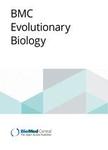版权所有:内蒙古大学图书馆 技术提供:维普资讯• 智图
内蒙古自治区呼和浩特市赛罕区大学西街235号 邮编: 010021

作者机构:Ocean Univ China Key Lab Marine Genet & Breeding Minist Educ Qingdao 266003 Peoples R China Auburn Univ Fish Mol Genet & Biotechnol Lab Aquat Genom Unit Dept Fisheries & Allied Aquacultures Auburn AL 36849 USA Auburn Univ Program Cell & Mol Biosci Auburn AL 36849 USA
出 版 物:《BMC EVOLUTIONARY BIOLOGY》 (BMC进化生物学)
年 卷 期:2010年第10卷第1期
页 面:6-6页
核心收录:
学科分类:0710[理学-生物学] 07[理学] 09[农学]
基 金:'863' Hi-Tech Research and Development Program of China [2006AA10A408, 2006AA10A402] National Nonprofit Special Grant of China [nyhyzx07-047] Key Laboratory of Mariculture of Ministry of Education, Ocean University of China Academy of Finland (AKA) Funding Source: Academy of Finland (AKA)
主 题:Internal Transcribe Spacer Gene Conversion Concerted Evolution Paternal Allele Unequal Crossover
摘 要:Background: Concerted evolution has been believed to account for homogenization of genes within multigene families. However, the exact mechanisms involved in the homogenization have been under debate. Use of interspecific hybrid system allows detection of greater level of sequence variation, and therefore, provide advantage for tracing the sequence changes. In this work, we have used an interspecific hybrid system of scallop to study the sequence homogenization processes of rRNA genes. Results: Through the use of a hybrid scallop system (Chlamys farreri female x Argopecten irradians male), here we provide solid molecular and cellular evidence for homogenization of the rDNA sequences into maternal genotypes. The ITS regions of the rDNA of the two scallop species exhibit distinct sequences and thereby restriction fragment length polymorphism (RFLP) patterns, and such a difference was exploited to follow the parental ITS contributions in the F1 hybrid during early development using PCR-RFLP. The representation of the paternal ITS decreased gradually in the hybrid during the development of the hybrid, and almost diminished at the 14th day after fertilization while the representation of the maternal ITS gradually increased. Chromosomal-specific fluorescence in situ hybridization (FISH) analysis in the hybrid revealed the presence of maternal ITS sequences on the paternal ITS-bearing chromosomes, but not vice versa. Sequence analysis of the ITS region in the hybrid not only confirmed the maternally biased conversion, but also allowed the detection of six recombinant variants in the hybrid involving short recombination regions, suggesting that site-specific recombination may be involved in the maternally biased gene conversion. Conclusion: Taken together, these molecular and cellular evidences support rapid concerted gene evolution via maternally biased gene conversion. As such a process would lead to the expression of only one parental genotype, and have the opportunities